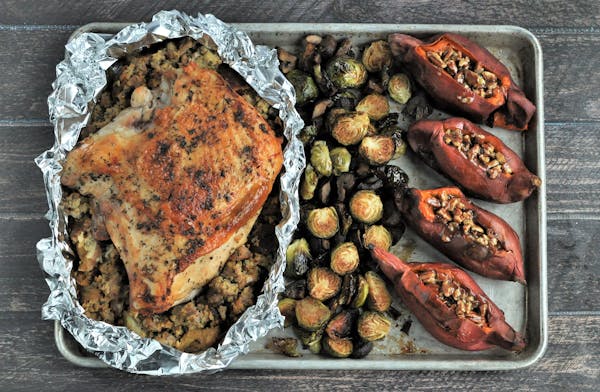On the menu this Thanksgiving: same foods as last year, but at higher prices.
As sticker shock rattles consumers in all areas of their lives, inflation has pushed the cost of the traditional holiday feast up significantly since the last time it was celebrated.
Fresh green beans? Up 11%. Potatoes? 13.5%. Fresh bread rolls? 16.5%, according to data provided by Spins, a Chicago-based consumer data firm, for the week ending Oct. 2.
In a survey conducted last month by the Hartman Group, 94% of people said they plan to celebrate. It will be an "especially challenging Thanksgiving," said Shelley Balanko, senior vice president of the consumer research firm.
"Everyone is feeling the effects of the stress and strain that our society has been under," Balanko said. "Not just with COVID but also inflation and rising prices as well as a whole host of social, political and economic occurrences this year."
The Hartman Group's research has found stretched consumers already turning to payment services that allow them to split a grocery bill over four installments.
"The fact that folks are relying on this for their grocery purchases is a little concerning," Balanko said.
In response to price-sensitive customers, some retailers are rolling out Thanksgiving promotions. On Nov. 2, Aldi introduced its "Thanksgiving Price Rewind," matching 2019 prices for many items with discounts of up to 30%. Walmart announced earlier this month that Thanksgiving products are reverting to last year's pricing.
As for the turkey centerpiece, procrastinators may be in luck. Retailer discounts are beginning to kick in, bringing down national whole bird turkey prices since early fall. According to the U.S. Department of Agriculture, the average price for frozen turkey hens fell to 97 cents a pound for the week ending Nov. 10, down from $1.14 a pound the week before — which is significantly lower than the $1.47 a pound in late October.
To keep the holiday costs manageable, here are a handful of techniques to trim expenses for both traditionalists and those seeking alternatives to the typical trimmings:
1. Start with a budget
Set a dollar limit, make a list and stick to it.
Joe Redden, a Carlson School of Management professor at the University of Minnesota, recently observed a grocery shopper in the checkout line monitoring the total as the final items were scanned. "At the end, there were four items they didn't buy," he said. That's one way to manage the budget.
Consumer research shows many have begun purchasing lower-priced store brands, Balanko said. They are often just as good, so no need to pick up brand names for Thanksgiving.
Shop around for lower prices. Look for ingredients at Trader Joe's and Costco or ethnic markets like Bill's Imported Foods, Holy Land and the many Asian markets in the Twin Cities.
Put your pandemic cooking skills to work rather than relying on restaurant or grocery store catering that's likely more expensive.
Check your fridge and pantry for items you already have. "I'm always buying something I already have at home because I didn't look," said Meredith Deeds, an Edina-based cookbook author.
2. Trim the menu
The most effective way to cut costs is to drop menu items, Redden said.
Instead of eight Thanksgiving menu items, serve seven. "My guess is no one's going to notice," he said.
As the head of a venture that focuses on intentional social interactions, Marnita Schroedl used to host a gathering of up to 90 and served 30 to 40 dishes to family, friends and anyone who needed a place to go.
During the pandemic, her Minneapolis gathering shrank to just her family. Now she makes only their favorite half-dozen items at a much lower cost: goose; sausage stuffing, lobster enchiladas, strawberry salad with caramelized cayenne almonds, pear pie and "Grandma's pumpkin pie."
An unexpected bonus: Her kids enjoy her lighter mood rather than seeing her stressed out Thanksgiving morning. "They wanted me to be more rested," said Schroedl, chief executive of Marnita's Table.
For those planning a small Thanksgiving table, a sheet-pan meal automatically limits the items. Deeds, the cookbook author, advocated for a sheet-pan approach in the Star Tribune in 2020 that includes turkey breast, stuffing, roasted sweet potatoes and Brussels sprouts, and is aimed at a guest list of two to four people.
"We all get into this caterer's mentality at Thanksgiving where we feel we need to have an abundance of items," Deeds said. "Usually we don't need quite all those things."
3. Practice shrinkflation
Adopt the strategy of food manufacturers that are keeping a product's price the same while shrinking contents and packaging.
"For Thanksgiving we can do the same thing. Get a turkey that's a little smaller. Maybe have a few less potatoes. Instead of having two pies, have one pie," Redden said. "At least for me, it's rare to say after a Thanksgiving meal that there wasn't enough food or 'I'm still hungry.'"
Make fewer of the side dishes that often wind up in the trash a week later. "You need to think back about previous Thanksgivings and the foods that ended up not getting eaten," Deeds said.
4. Leverage potluck
For many, Thanksgiving is a potluck by nature.
Don't be shy this year with family, friends or guests. Suggest everyone bring wine, or another drink and dish, to share.
Be strategic. Asks guests what dishes they'll bring to avoid overlap. "The rookie pot luck error is to just say bring a dish and then everyone brings cranberry Jell-O fluff," Deeds said.
5. Try something else
Not everyone likes turkey. Many will host vegetarians or vegans who don't eat it. Recent immigrants from Mexico and Somalia may not have adopted the turkey-with-all-the-trimmings tradition.
No pressure. This could be a cost-cutting opportunity. Consider a squash casserole or soup centerpiece for a vegan gathering. Or, a Mexican spread.
Redden's family isn't into turkey, so his Thanksgiving table is centered around an affordable breakfast, complete with eggs, bacon and waffles.
"My kids really like that."
